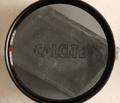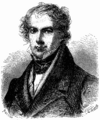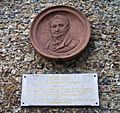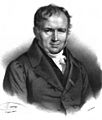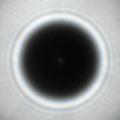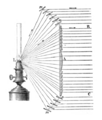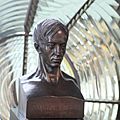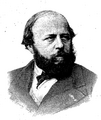Augustin-Jean Fresnel facts for kids
Quick facts for kids
Augustin-Jean Fresnel
|
|
|---|---|
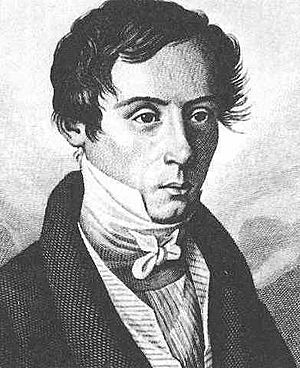
Portrait of "Augustin Fresnel"
from the frontispiece of his collected works (1866). |
|
| Born | 10 May 1788 Broglie, Kingdom of France (now Eure, France)
|
| Died | 14 July 1827 (aged 39) |
| Cause of death | Tuberculosis |
| Resting place | Père Lachaise Cemetery |
| Nationality | French |
| Education |
|
| Known for |
|
| Awards |
|
| Scientific career | |
| Fields | Physics, Engineering |
| Institutions |
|
| Influences | |
| Influenced |
|
Augustin-Jean Fresnel (10 May 1788 - 14 July 1827), was a French was a French civil engineer and physicist whose research in optics led to the almost unanimous acceptance of the wave theory of light. Fresnel studied the behaviour of light both theoretically and experimentally.
He is perhaps best known as the inventor of the Fresnel lens, first adopted in lighthouses while he was a French commissioner of lighthouses, and found in many applications today. His equations on waves and reflectivity also form the basis for many applications in computer graphics today - for instance, the rendering of water.
Contents
Biography
Fresnel was the son of an architect, born at Broglie (Eure). His early progress in learning was slow, and he still could not read when he was eight years old. At thirteen he entered the École Centrale in Caen, and at sixteen and a half the École Polytechnique, where he acquitted himself with distinction. From there he went to the École des Ponts et Chaussées. He served as an engineer successively in the departments of Vendée, Drôme and Ille-et-Vilaine; but having supported the Bourbons in 1814 he lost his appointment on Napoleon's return to power.
In 1815 on the second restoration of the monarchy he obtained a post as engineer in Paris, where he spent much of his life from that time onwards. He appears to have begun his research in optics around 1814 when he prepared a paper on the aberration of light, although it was never published. In 1818 he wrote a memoir on diffraction for which he received the prize of the Académie des Sciences at Paris in the ensuing year. He was the first to construct a special type of lens, now called a Fresnel lens, as a substitute for mirrors in lighthouses. In 1819 he was nominated to be a commissioner of lighthouses. In 1823 he was unanimously elected a member of the academy, and in 1825 he became a member of the Royal Society of London. In 1827, the time of his last illness, the Royal Society of London awarded him the Rumford Medal.
Fresnel died of tuberculosis at Ville-d'Avray, near Paris.
He received only scant public recognition during his lifetime for his labours in the cause of optical science. Some of his papers were not printed by the Académie des Sciences until many years after his death. But as he wrote to Young in 1824: in himself "that sensibility, or that vanity, which people call love of glory" had been blunted. "All the compliments," he says, "that I have received from Arago, Laplace and Biot never gave me so much pleasure as the discovery of a theoretic truth, or the confirmation of a calculation by experiment".
His name is one of the 72 names inscribed on the Eiffel Tower.
Research
His discoveries and mathematical deductions, building on experimental work by Thomas Young, extended the wave theory of light to a large class of optical phenomena. In 1817, Young had proposed a small transverse component to light, while yet retaining a far larger longitudinal component. Fresnel, by the year 1821, was able to show via mathematical methods that polarization could be explained only if light was entirely transverse, with no longitudinal vibration whatsoever.
He proposed the aether drag hypothesis to explain a lack of variation in astronomical observations.
His use of two plane mirrors of metal, forming with each other an angle of nearly 180°, allowed him to avoid the diffraction effects caused (by the apertures) in the experiment of F. M. Grimaldi on interference. This allowed him to conclusively account for the phenomenon of interference in accordance with the wave theory.
With François Arago he studied the laws of the interference of polarized rays. He obtained circularly polarized light by means of a rhombus of glass, known as a Fresnel rhomb, having obtuse angles of 126° and acute angles of 54°.
Perhaps Fresnel's most widely interpreted written work was his Memoir on the Diffraction of Light, submitted to the Academe of science in 1812.
Legacy
Fresnel's legacy is the more remarkable in view of his lifelong battle with tuberculosis, to which he succumbed at the age of 39. Although he did not become a public celebrity in his short lifetime, he lived just long enough to receive due recognition from his peers, including (on his deathbed) the Rumford Medal of the Royal Society of London, and his name is ubiquitous in the modern terminology of optics and waves.
Images for kids
-
Monument to Augustin Fresnel on the facade of his birthplace at 2 Rue Augustin Fresnel, Broglie (facing Rue Jean François Mérimée), inaugurated on 14 September 1884. The inscription, when translated, says: "Augustin Fresnel, engineer of Bridges and Roads, member of the Academy of Sciences, creator of lenticular lighthouses, was born in this house on 10 May 1788. The theory of light owes to this emulator of Newton the highest concepts and the most useful applications."
-
Bas-relief of Fresnel's uncle Léonor Mérimée (1757–1836), on the same wall as the Fresnel monument in Broglie
-
A right-handed/clockwise circularly polarized wave as defined from the point of view of the source. It would be considered left-handed/anti-clockwise circularly polarized if defined from the point of view of the receiver. If the rotating vector is resolved into horizontal and vertical components (not shown), these are a quarter-cycle out of phase with each other.
-
Chromatic polarization in a plastic protractor, caused by stress-induced birefringence.
-
First-order rotating catadioptric Fresnel lens, dated 1870, displayed at the Musée national de la Marine, Paris. In this case the dioptric prisms (inside the bronze rings) and catadioptric prisms (outside) are arranged to give a purely flashing light with four flashes per rotation. The assembly stands 2.54 metres tall and weighs about 1.5 tonnes.
-
Bust of Augustin Fresnel by David d'Angers (1854), formerly at the lighthouse of Hourtin, Gironde, and now exhibited at the Musée national de la Marine
See also
 In Spanish: Augustin Fresnel para niños
In Spanish: Augustin Fresnel para niños







